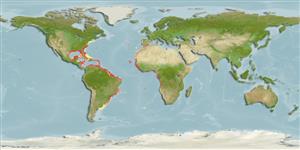>
Carangiformes (Jacks) >
Carangidae (Jacks and pompanos) > Caranginae
Etymology: Chloroscombrus: Greek, chloros = green + Greek, skombros = the name of several fishes, a mackerel (Ref. 45335).
More on author: Linnaeus.
Environment: milieu / climate zone / depth range / distribution range
पारिस्थितिकी
समुद्री; खारा; गहराई सीमा 0 - 110 m (Ref. 114025). Subtropical; 42°N - 41°S, 98°W - 14°E
Western Atlantic: Massachusetts to Florida, USA and Bermuda to Uruguay; throughout Caribbean Sea and Gulf of Mexico (Ref. 9626); Bahamas, Antilles, along Central and South American coasts to Uruguay (Ref. 26938). Eastern Atlantic: Spain to Angola (Ref. 57392). First recorded from the Mediterranean Sea (Ref. 128468).
Replaced by Chloroscombrus orqueta in eastern Pacific. These two species have not been adequately studied and may prove to be conspecific.
Length at first maturity / आकार / वज़न / Age
Maturity: Lm 12.4, range 10 - ? cm
Max length : 65.0 cm TL पुल्लिंग / अलिंग; (Ref. 57392); common length : 25.0 cm TL पुल्लिंग / अलिंग; (Ref. 5217); अधिकतम प्रकाशित वज़न: 121.00 g (Ref. 128468)
पृष्ठीय रीढ़ (सम्पूर्ण) : 9; पृष्ठीय सौफट रेज़ (सम्पूर्ण) : 25 - 28; गुदा कांटा: 3; ऐनल सौफट रेज़: 25 - 28. Diagnosis: body compressed and deep (depth comprised from 2.3 to 2.8 times in fork length) (Ref. 57392), its ventral profile distinctly more convex than the dorsal (Ref. 26938, 57392). Snout very short, its tip blunt, upper jaw extending almost to behind level of anterior eye margin; 2 dorsal fins, the first with 8 spines, the second with 1 spine and 25-28 soft rays; anal fin with 2 detached spines, followed by 1 spine and 25-28 soft rays; upper lobe of caudal fin longer than the lower; small, cycloid scales covering most of body, including chest; 5-15 weak scutes on posterior part of lateral line, at level of caudal peduncle, the latter without bilateral keels (Ref. 57392). Metallic blue above, silvery below; caudal peduncle with black saddle spot (Ref. 3197).
Coloration: back greenish or bluish, sides silvery-white; a dark, saddle-shaped blotch on caudal peduncle just before caudal fin, and another at upper angle of gill cover (Ref. 57392).
Adults are found over soft bottoms of the continental shelf; sometimes forming schools near the surface (Ref. 5217). Marine pelagic species very common in coastal lagoons and estuaries (Ref. 57392). They feed on fish, cephalopods, zooplankton and detritus (Ref. 28587). Juveniles common in brackish estuaries and often associated with jellyfish (Ref. 5217). Marketed fresh and salted.
Life cycle and mating behavior
Maturities | पुनरुत्पत्ति | Spawnings | Egg(s) | Fecundities | लार्वा
Smith-Vaniz, W.F., J.-C. Quéro and M. Desoutter, 1990. Carangidae. p. 729-755. In J.C. Quero, J.C. Hureau, C. Karrer, A. Post and L. Saldanha (eds.) Check-list of the fishes of the eastern tropical Atlantic (CLOFETA). JNICT, Lisbon; SEI, Paris; and UNESCO, Paris. Vol. 2. (Ref. 7097)
IUCN Red List Status (Ref. 130435)
Threat to humans
Harmless
Human uses
मात्स्यिकी: व्यापारिक
साधन
Special reports
Download XML
इंटरनेट स्रोत
Estimates based on models
Preferred temperature (Ref.
123201): 23.2 - 28, mean 26.2 °C (based on 552 cells).
Phylogenetic diversity index (Ref.
82804): PD
50 = 0.7500 [Uniqueness, from 0.5 = low to 2.0 = high].
Bayesian length-weight: a=0.01259 (0.01111 - 0.01426), b=2.94 (2.91 - 2.97), in cm total length, based on LWR estimates for this species (Ref.
93245).
Trophic level (Ref.
69278): 3.5 ±0.2 se; based on diet studies.
Generation time: 5.0 ( na - na) years. Estimated as median ln(3)/K based on 2
growth studies.
लौटाव (Ref.
120179): माध्यम, न्यूनतम जनसंख्या दुगनी होने का समय 1.4 - 4.4 वर्ष। (K=0.22-0.56).
Prior r = 0.57, 95% CL = 0.37 - 0.85, Based on 3 data-limited stock assessments.
Fishing Vulnerability (Ref.
59153): Low to moderate vulnerability (29 of 100).
Climate Vulnerability (Ref.
125649): High to very high vulnerability (75 of 100).
Nutrients (Ref.
124155): Calcium = 90.6 [51.1, 199.0] mg/100g; Iron = 1.79 [1.02, 3.33] mg/100g; Protein = 20.3 [19.1, 21.5] %; Omega3 = 0.442 [0.268, 0.757] g/100g; Selenium = 26.1 [13.5, 51.0] μg/100g; VitaminA = 6.02 [1.87, 18.28] μg/100g; Zinc = 0.834 [0.576, 1.190] mg/100g (wet weight);
